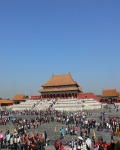Forbidden City
Archaeology »
Archaeological Monuments » Forbidden City
Forbidden City -
Forbidden City is located in Beijing.
Forbidden City monument was established on 1925.
Primary threats to Forbidden City :
Historical facts of Forbidden City :
- The Forbidden City, located in the heart of Beijing, China, is a world-renowned UNESCO World Heritage Site and one of the most iconic landmarks in the country. With a history spanning over 600 years, the Forbidden City served as the imperial palace during the Ming and Qing dynasties and is steeped in historical significance. Let's delve into the historical facts surrounding the Forbidden City.
- Construction of the Forbidden City began in 1406 during the early Ming Dynasty, under the orders of Emperor Zhu Di, also known as Emperor Yongle. It took approximately 14 years and a vast workforce of artisans, laborers, and craftsmen to complete the grand palace complex.
- The Forbidden City, originally called the Palace City, was designed as the imperial residence for the emperors of the Ming and Qing dynasties. It was named the Forbidden City because access was strictly limited to the emperor, his family, and authorized court officials. Ordinary citizens were forbidden from entering its premises, hence its name.
- The architecture of the Forbidden City reflects traditional Chinese design and symbolism. The complex spans over 180 acres and is comprised of 980 surviving buildings, making it the largest palace complex in the world. The buildings are adorned with exquisite decorations, vibrant colors, and intricate details, showcasing the skill and craftsmanship of the imperial artisans.
- The Forbidden City consists of three main sections: the Outer Court, the Inner Court, and the Imperial Garden. The Outer Court served as the ceremonial and administrative center, hosting important state affairs and grand ceremonies. Here, the emperor would hold court and address matters of governance.
- The Inner Court, also known as the Palace of Heavenly Purity, was the private living quarters of the emperor and his family. It housed the imperial residences, concubines' quarters, and various palaces dedicated to different functions. The Inner Court was considered the most sacred and restricted area of the Forbidden City.
- The Imperial Garden, located at the northern end of the complex, provided a tranquil retreat for the emperor and his family. It featured beautiful pavilions, rockeries, and lush greenery, creating a serene environment amidst the bustling palace.
- Throughout its history, the Forbidden City witnessed significant political and cultural events. It served as the center of power and symbolized the supreme authority of the emperors. Important ceremonies, such as imperial weddings and coronations, took place within its walls. The palace complex was also home to a vast collection of precious artifacts, including imperial treasures, artworks, and cultural relics.
- In 1925, after the fall of the Qing Dynasty and the establishment of the Republic of China, the Forbidden City was transformed into the Palace Museum. The vast collection of cultural artifacts housed within its walls became accessible to the public, allowing visitors to appreciate the rich heritage of Chinese civilization.
- Today, the Forbidden City remains a popular tourist attraction and an enduring symbol of China's imperial past. Its historical significance, architectural splendor, and cultural treasures continue to captivate visitors from around the world. The Forbidden City stands as a testament to China's rich history and serves as a window into the grandeur and legacy of its ancient imperial civilization.

